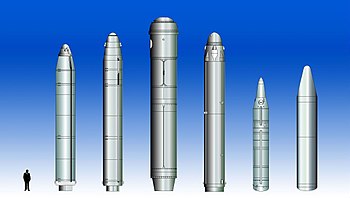| R-39 RIF | |
|---|---|
 R-39 | |
| Type | SLBM |
| Place of origin | Soviet Union |
| Service history | |
| In service | 1983–2004 |
| Used by | Soviet Navy Russian Navy |
| Production history | |
| Designer | Makeyev Rocket Design Bureau |
| Manufacturer | Zlatoust Machine-Building Plant |
| Specifications | |
| Mass | 84 tonnes (185,000 lb) |
| Length | 16.1 metres (53 ft)[1] (8.4 metres (28 ft) without warhead) |
| Diameter | 2.4 metres (7.9 ft)[1] |
| Warhead | 10 MIRV thermonuclear[1] |
| Blast yield | 100–200 kt each[1] |
| Engine | Three-stage Solid-fuel rocket[1] |
Operational range | 8,300 kilometres (5,200 mi)[1] |
Guidance system | Astro-inertial guidance[2] |
| Accuracy | 500 metres (1,600 ft) CEP[2] |

The R-39 Rif (Russian: Р-39 Риф, lit. 'reef'; NATO reporting name: SS-N-20 Sturgeon; bilateral arms control designation: RSM-52) was a submarine-launched ballistic missile (SLBM) that served with the Soviet Navy from its introduction in 1983 until 1991, after which it served with the Russian Navy until 2004. The missile had GRAU indices of 3M65, 3M20, and 3R65. It was carried on board Typhoon-class submarines.
An intercontinental missile, the R-39 had a three-stage solid-fuel boost design with a liquid-fuel post-boost unit carrying up to ten multiple independently targetable reentry vehicle warheads. Like other SLBMs the initial launch was powered by a gas generator in the bottom of the firing tube. During the missile's passage through the water additional motors produce a gaseous wall around the missile, reducing hydrodynamic resistance.[citation needed] The launch system was designated "D-19".